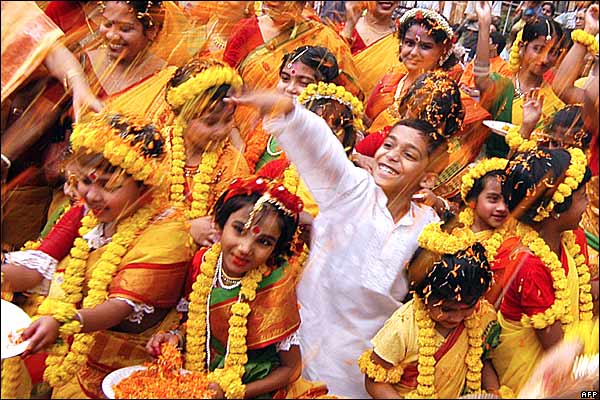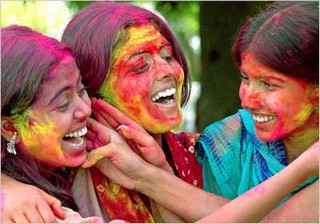

The mood & backdrop:
Holi, the great Indian festival of colors, is a unique celebration of high spirits, when the new season is courted
with a riot of rich colors. It is like a grand kaleidoscope that glorifies all the hues that tinge and renew the lives
on earth as the refreshing and rejuvenating breeze from the south, heralds the onset of the ensuing summer in this part of the world.
It is thus a festival of spring. The time when the seasonal cycle is caught in a transition. This is when nature starts
donning new color. The new foliages start sprouting on the branches, dried and weary over a winter. It is also time
when the harvests are reaped and bundled in sheaves. The air is filled with promises of warmth and new lives as the
earth discards the wintry glum to greet the bright sun of summer. Beset with this exhilarating backdrop, Holi comes to mark the renewal
and rebirth of life. Holi is thus a celebration of life, the life of love, unblemished joy, and good spirits.
The spirit & significance of colors:
Holi has assumed a national flavor over the ages. Despite being a Hindu festival, it is now regarded as a secular event.
The entire nation takes the day off. People, irrespective of race, culture and ethnic background,enjoy the spirit of Holi.
Cities and suburbs, towns and villages all come alive to catch the frenzy of March madness with a range of colors.
Celebrating the mood of nature with a range of colors. This is what colors of Holi signify. The spirit of celebration
is to showcase the shifting panorama of life, of sights, movement and feelings. The human hearts also feel the urge to be
recharged with new colors to catch the mood outside. Holi is a reminder that the time is perfect to be colored, to renew love
and recharge our vitality. The color is symbolic of the energy, passionate pulse of life and vitality.
In North India and Uttar Pradesh:
In North India and Uttar Pradesh,the victory is celebrated, effigies of Holika are burnt in the huge bonfires.
Lord Krishna spent most of his childhood in Mathura and Vrindavana. He was the one to introduce the modern form of Holi
and thus Holi is celebrated with great enthusiasm at these places for about a week. Situated in Uttar Pradesh, all the
major temples of the region dedicated to Krishna and Radha celebrate Holi on a different day. In these parts
celebrating Holi means getting drenched with colored water during these celebrations is considered to be a blessing from
god and is considered auspicious. Since Radha belonged to Barsana while Krishna belonged to Nandagaon, on the day of Holi,
men from Nandagaon go to Barsana to celebrate Holi with the women there. The playful teasing of women and attempts to color
them with 'gulal' and wet colors from 'pichkari' is returned by them by attempts to escape and beating the men with sticks
to scamper them away.
Holi in Braj:
In Braj, Holi festivities begin from Barsana. Holi which is about 8 days earlier than the actual Holi. It is the second
largest festivity of Barsana when thousands and thousands of people arrive from around Braj to watch the most spectacular
and amazing style of Barsana Holi celebration. After that, Holi is celebrated in different styles in various
places of Braj at different dates. The lanes of Vrindaban become red as all the people play Holi with colored powder and water
sprayed from pichkaris(special squirts). Everyone is covered in color. Traditional songs called rasiya are sung on Holi.
Sweets are distributed and friends and family come together to celebrate fostering social harmony.
Haryana:
In Haryana, the brides of the Hindu undivided families hang a pot of buttermilk high up in the streets as a challenge to their
brother-in-laws, who try to get ot break the pot by forming a human pyramid to reach it. Women try to stop them by beating them with their
saris rolled up as ropes. This mock-drama is staged to commemorate the playful pranks of child Krishna, who would steal milk, butter and
curd from the cow maids' houses. In the evening, the brother-in-laws bring sweetmeats for the women of the house for their contribution
keeping the family united.
Western India:
Like Haryana, Maharashtra and Gujarat also has mock-drama of Krishna trying to break the pots and steal the butter. Besides, the men of
these states take out a grand procession while soaked with colored water as they walk through the streets to make a mock alert call to
ask people and women of the house to take care of their pots of butter and milk as Krishna may come in and steal them.This tradition is
also followed in Gujarat and Orissa.To render greatfulness to Agni, god of Fire, gram and stalks from the harvest
are also offered to Agni with all humility.
Eastern India:
In Bengal, Holi is called Dol Yatra (the Swing Festival) in which dolls of Krishna and Radha are placed on swings and devotees take turns to
swing them. Women perform devotional songs and dances around the swing as men spray colored water and 'Abeer' (colored powder) on them.
However, the tradition is being lost in the modern wave and people play with colored water and powders in the morning and then take out
processions on the streets with music and drums while stained with Holi colors. Orissa has similar traditions as Bengal.
North East:
Holi is a six-day long in Manipur and commences on the full moon day of Phalguna. In the 18th century, it merged with the traditional and
centuries-old Yaosang festival of Manipur. In earlier times, there were folk songs and dance performances under the moonlight accompanied
by the indigenous drums. Today, modern musical instruments have replaced the drums and fluorescent lamps have replaced the moonlight.
Days before, people collect money from the community for the expenses on the festivities. A thatched hut of hay, twigs and sticks is built,
only to be set ablaze. Next morning, groups of boys go to play 'gulal' with the girls and pay them money to get the favor. Devotees play
'gulal', sing devotional songs and dance in front of the Krishna temple dressed in the traditional white and yellow turban. On the last day
of the festival, a grand procession is taken out to the main Krishna temple in the capital of Manipur, Imphal where multitude of cultural
programs take place.
